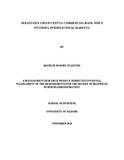| dc.description.abstract | Today, banks are operating internationally in order to reach out to more customers and increase
their profitability. In their quest to venture into the international markets, the banks tend to use
different challenges that could be similar to other banks or that are special to that particular bank.
This study sought to find out which strategies have been used by Kenya Commercial Bank as it
expands its horizons to the international markets. The bank’s major strategies revolved around
the entry mode, expansion and operation strategies which the bank sought to use while entering
into these markets. The main strategies included competitive advantage, return on investments
and the market analysis portfolios expansion and operation strategies included, market
penetration, product development and wholly owned subsidiaries. The study used primary data
collected from senior managers of the bank by way of a questionnaire. This was the most
appropriate method of collecting data as it involved the key people who make decisions regarding the banks expansion programs.
The study found out that strategy analysis and implementation was really important in the bank’s
decision of entering the international markets. The different markets of the country determined
the nature of the business environment. Its regulations thus determined how safe the bank felt its
operations would be. The competition in these countries determined how the bank would
approach the market and how this reflected on the business. The bank also had to foresee growth
in these regions so as to do business there. Competitive Advantage was the most chosen mode of entry strategy for the bank as it sought to enter these markets. Market demand greatly affected the location of the branches. Product development as an expansion strategy affected the decision of which products to promote as some are focused on some age brackets. Product development also affected entry especially in Muslim affiliated countries as they do not have conventional banking. Mode of operation, which was the wholly owned foreign subsidiaries, determined how seamlessly the bank operations
would flow. New products and services of competitors determined how much customers the
bank got and their volumes in relation to the products offered. In conclusion, the project hopes to
help assist other local banks who would wish to do international business on how to come up
with the best strategy while internationalizing. The study also aims to assist the management of
the bank to deal with past problems and create best strategies while moving to other countries. | en |

